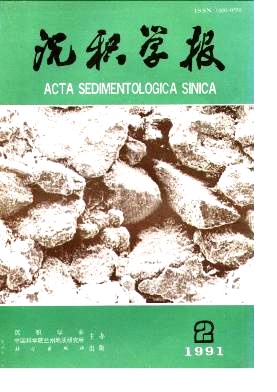Apply Grain-Size Distribution of Clastics in Identifying Dry Playa Sequences
- Received Date: 1989-01-27
- Publish Date: 1991-06-10
Abstract: Field work proves that the modern dry playas in the Kenteyi Playa lake of Qaidan Basin have been under gone two main formation courses: 1) Subfluvial sedimentary process in common saline lakes.Their mechanical sediments mainly consists of suspended fine particles, fluvial and aeolian, dispersed or interbedded in salt-bearing beds; 2) subaerial sedimentary and/ or remaking process on playas after drying.Aeolian dust adhesion sedimentation develops at the beginning of this stage, then coarser sands deposit, with aeolian erosion in some case. While the playa are dissolved and remade by rain and evaporation so the mechanical sediments and evaporite deposits are mixed, the earlier and the latter materials get together in one bed, formed the dry playa sequence. By grain-size analysis and correlation, the clastic sediments in the modern saline lakes and playas have clearly different distribution characteristics: The former has a single peak frequence curve, spread out, consists mainly of fine and poor sorted sediments (silts and clays); And the latter is a very complicated poly-peak frenquence curve, which can be generally devided into two parts, a coarser one and a finer one.The coarser one has a relatively steep cumulative curve with a "median" range 0-2Φ and well sorted.Its frequence curve is left-side skewed. These features stand for aeolian sand sediments, which are the added part after drying the finer one is similar to the curve of the modern saline drying.The finer one is similar to the curve of the modern saline 5Φ.So they are the original sediments formed in common saline lakes before dry ing.It is clear that the grain-size distribution characteristics is a good indicator to indentify playa sequence. Using the results got above from modern samples, some dry playa sequences are revealed which can be correlated horizontally in the different sections.Potash deposits (such as polyhalite ) and K+-rich interstital brines just occur at these dry playa intervals. It proves that potash accumulation is closely related to dry playas, and it shows that the grain-size analysis method can be used in prospection potash deposits. Grain-size analysis firsthand datas have been delt with by a computer in order to use and interpret easily, and the result shows that the datas of saline lake elastics are generally approximated to one population still; but the datas of dry playa sediments to two or more sub-populations, indicating that they derived from more than one sedimentary processes. That is identical with geological observation and discussion above.
| Citation: | Hu Wenxuan. Apply Grain-Size Distribution of Clastics in Identifying Dry Playa Sequences[J]. Acta Sedimentologica Sinica, 1991, 9(2): 71-77. |






 DownLoad:
DownLoad: